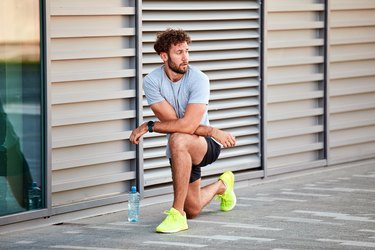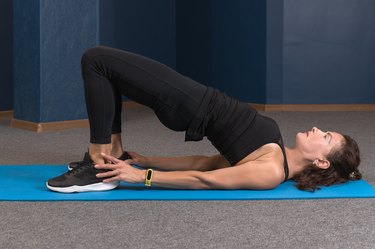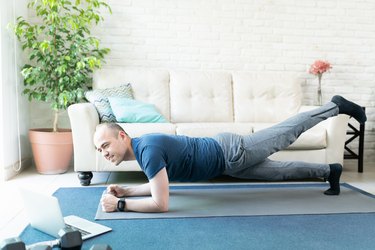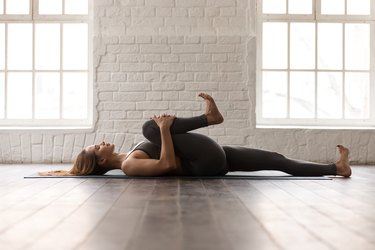
In the world of fitness, tight hips has become a hot topic. The term pops up often, especially in reference to things like back and knee pain. It seems like the condition is a catchall culprit for many other bodily aches. But what exactly does it mean to have tight hips?
"Tight hips" generally refers to tension in the hip joint (mobility restriction) or the muscles that attach to/surround the hip joint (flexibility restriction), explains Sam Becourtney, DPT, CSCS, physical therapist at Bespoke Treatments.
Video of the Day
Video of the Day
This tightness is incredibly prevalent — especially when it comes to your hip flexors.
Your hip flexors run across the front of your body and connect your thighs to your pelvis. They work to raise your thigh toward your torso, and lower your torso toward your thigh.
"When we sit, our hips are naturally in a flexed position (hips/knees bent), so as a result [of prolonged sitting], we tend to adopt this posture as our new 'natural' position," he says. (Thanks, sitting disease.)
But due to their placement and role in your body, when your hip flexors are tense, they can negatively affect total-body alignment and muscle function. Other parts of your body start to compensate for a lack of hip mobility and your risk of injury increases. (Hence, the back and knee pain.)
Warning
If your hip tightness (or pain) persists or negatively affects your quality of life, see your doctor or physical therapist. They can help you determine the underlying cause and prescribe a proper course of treatment.
How Do You Know if Your Hips Are Tight?
4 Signs of Tight Hip Flexors
Hip restriction doesn't always cause pain, but it can. Here are the most common signs of tightness around the hip joint, according to Becourtney.
- Extreme lower back arching, called lordosis
- Difficulty kicking your leg behind you
- Lower back pain
- Localized hip discomfort
Notice one or more of these signs? There are two follow-up tests for hip tightness that can help give you a more definitive diagnosis.
1. The Thomas Test
This is most common and effective method for assessing hip flexor flexibility and mobility.
Consider seeing a trained professional like a physical therapist who can assess your situation, but you can also perform this test at home on your own:
- Lie on your back on the edge of your bed or a bench.
- Bring both knees to your chest.
- Continue holding your right knee and straighten the left leg, allowing it to fully relax.
- Repeat with the other leg.
If the back of your bottom thigh doesn't touch the bench or bed, or your knee remains fairly straight (it should be bent when relaxed), you have tight flexors, Becourtney says.
2. The Standing Hip-Flexor Test
You can also gauge hip tightness from a standing position:
- Stand in front of a mirror.
- Kick one leg behind you as far as possible (keeping the knee straight/extended) without arching the lower back. Then repeat on the opposite leg.
- In the mirror, note any compensations or differences between the left and right side.
In this scenario, you're looking for any tension or discomfort in the front (anterior portion) of your thigh. An inability to extend your leg very far behind you is another sign of limited hip mobility, Becourtney says.
The Best 3 Ways to Loosen Tight Hip Flexors
The smartest strategy for relieving tight hips depends on your specific situation (and the root cause of your tightness).
Again, it's wise to see a physical therapist who can properly assess and tailor an individualized treatment plan.
That said, in general, there are three main ways to help loosen tight flexors. Do them all, and you'll be in good shape.
1. Stretch
"If the tightness is due to a muscular length issue (decreased length leads to tightness), then stretching the hip flexors may allow you to loosen up these tight hips based on the muscular attachment points in the body," Becourtney says.
He recommends doing dynamic hip stretches that use the antagonist or opposing muscles (in this case, the glutes) for a deeper stretch. The half-kneeling hip flexor stretch is the best place to start:
Move: Half-Kneeling Hip Flexor Stretch
- Start kneeling on your right knee in front of a bench. Your left leg should be bent with your left foot planted on the floor.
- Raise your back right foot and rest your ankle on the bench.
- Keep your pelvis in a neutral position (not tilted forward or backward) and squeeze the glute of your back leg (this will deepen the stretch down the front side of your right leg in your hip flexors).
- Extend your right arm as you twist to your left side, reaching your arm across your body. Hold this stretch for up to 5 seconds before returning to the neutral starting position.
- Complete 2 sets of 5 reps on each side.
2. Strengthen
"A lot of times, hip tightness is actually a result of weakness," Becourtney says. "Weakness can present itself as tightness as your body's way of trying to minimize the likelihood of injury/pain."
Here's why: If you have weak hip flexors, your body isn't comfortable lifting in/out of hip flexion. As a result, your muscles guard and tighten to avoid that uncomfortable flexed position. Your muscles basically think they're protecting you, but they're really hurting you.
"Thus, if we can strengthen the weak muscles, the body will no longer have this perceived fear of certain movements, and there will be inherent relaxation of the tight muscles," he explains.
Becourtney recommends incorporating both specific hip-flexor exercises as well as compound strength movements into your routine.
Exercises like the long-sitting hip-flexor lift, band-resisted knee drive and leg lift can help you increase muscular endurance, he says. Try doing 3 to 4 sets of 12 to 15 reps 2 to 3 times per week.
As for compound movements like squats and step-ups, do 3 to 4 sets of 6 to 8 reps once or twice per week.
Move 1: Long-Sitting Hip Flexor Lift
- Sit up tall against a wall with your legs extended straight out in front of you. Place a small object like a dumbbell or kettlebell between your feet.
- Brace your core and squeeze your thigh as you lift your right leg (keeping it straight) over the object.
- With control, lower your leg to the floor and pause briefly before reversing the movement.
- Do all reps, then repeat on the other side.
Move 2: Band-Resisted Knee Drive
- Stand with a mini band looped around your shoes just above the laces.
- Brace your core and maintain a straight spine as you drive one knee up toward your chest. (Don't swing the leg — make sure it's a controlled movement.)
- Hold for a second at the top, then slowly lower the leg and continue for the specified number of reps.
- Repeat on the other side.
Move 3: Leg Lift
- Lie on the ground with your legs out straight, arms at your sides. You can place your hands under your tailbone for more support.
- Brace your core and root your lower back into the ground.
- Raise your legs straight up toward the ceiling.
- Lower your legs back toward the ground, keeping your lower back in contact with the floor.
- Hover your feet just above the ground before rising for the next rep.
Move 4: Squat
- Stand with your feet hip-width apart. Turn your feet to point out to the side just slightly.
- Hinge at your hips and bend your knees (as if you were going to sit in a chair) while keeping your chest up.
- Either raise your arms out in front of you at shoulder height for balance or bring your hands up to your chest.
- Keep your feet flat on the floor and don't arch your lower back.
- Now check your knees: They should be pointing in the direction of your toes (not collapsing in or bowing out) and shouldn't extend past your toes.
- Once you've lowered as far as your hip flexibility will allow, squeeze your glutes and stand back up.
Move 5: Step-Up
- Stand in front of a sturdy step, chair or bench (when you place your foot on it, your knee should bend to a 90-degree angle).
- Place your entire right foot onto the step, bench or chair, pressing through your right heel to straighten your right leg.
- Lift the left foot to meet your right foot on top of the step, chair or bench.
- Bending your right knee, step down with the left foot followed by the right foot.
- Repeat on the left side.
3. Move More
This one's a simple solution: Get up and move.
"If we can take a movement break every 60 minutes or so, even just for five minutes and walk around, this can help us to get our hips into an extended position and relax out of the posture that we spend 8-plus hours in daily while sitting," Becourtney says.
Related Reading



